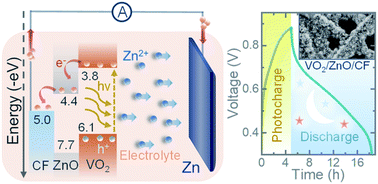Vanadium dioxide–zinc oxide stacked photocathodes for photo-rechargeable zinc-ion batteries†
Abstract
The development of batteries that can be recharged directly by light, without the need for external solar cells or external power supplies, has recently gained interest for powering off-grid devices. Vanadium dioxide (VO2) has been studied as a promising photocathode for zinc-ion batteries because it can both store energy and harvest light. However, the efficiency of the photocharging process depends on electrode structure and charge transport layers. In this work, we report photocathodes using zinc oxide as an electron transport and hole blocking layer on top of which we synthesise VO2. The improved interface and charge separation in these photocathodes offer an improvement in photo-conversion efficiency from ∼0.18 to ∼0.51% compared to previous work on mixed VO2 photocathodes. In addition, a good capacity retention of ∼73% was observed after 500 cycles. The proposed stacked photocathodes reduce the battery light charging time by 3-fold and are therefore an important step towards making this technology more viable.



 Please wait while we load your content...
Please wait while we load your content...